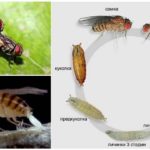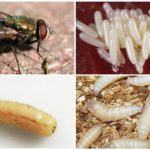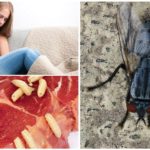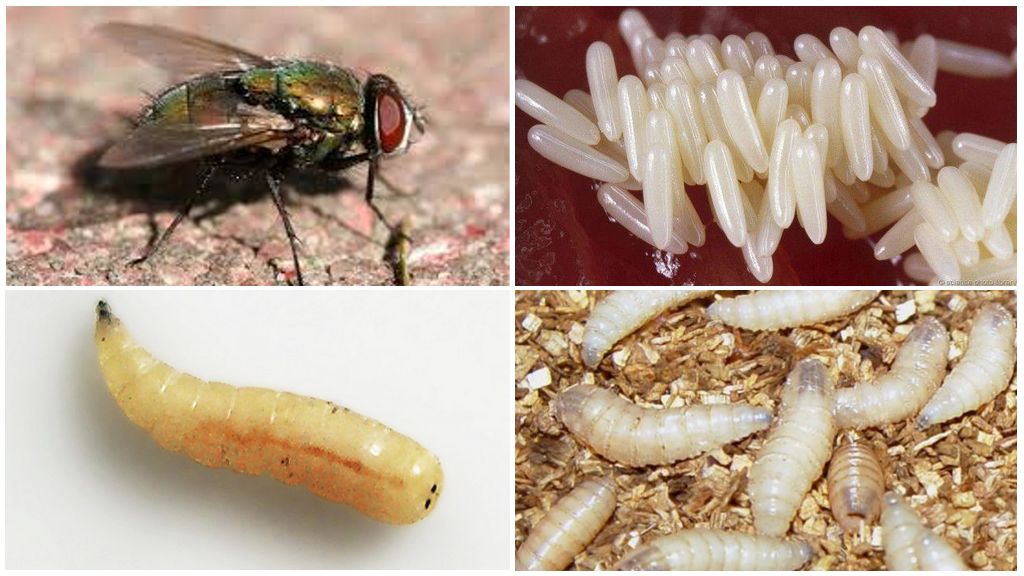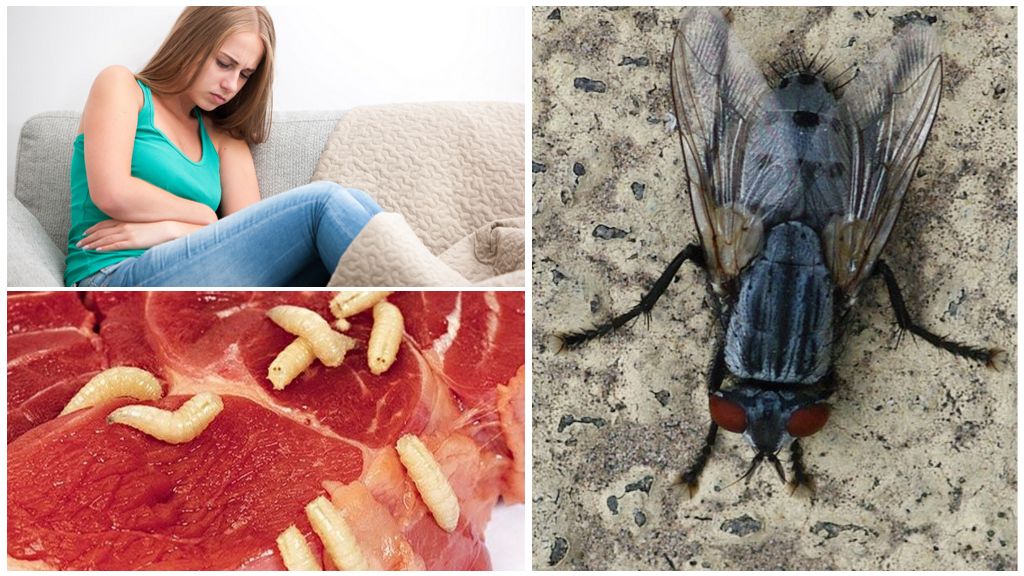Description and photo of larvae and eggs of flies
Content
- Fly breeding
- Eggs and fly larvae
- Intestinal poisoning due to maggots
- Fighting maggots
The larvae of flies are extremely mobile white worms. Do not have legs, but move with the help of special hooks. Many females lay eggs, but there are also viviparous flies. Man is well known synanthropic housefly, which is practically not able to live in the wild, meat, meat or carrion. The larvae of these species are similar in appearance, but somewhat different habitat, lifestyle.
Female fecundity
Flies acquire the ability to fertilize the day after their birth. Young females lay about 70 eggs at a time, more mature individuals - up to 120 eggs. Eggs of flies are oval, off-white color, no more than 1 mm in size. Always located in clusters. Photos of eggs flies can be seen below.
Flies on stage imago live from 14 days to 2 months depending on climatic conditions. During his life he has time to lay about 2 thousand eggs. Begin to be active in early spring, when the air temperature rises to +10 degrees Celsius. In late September, October, with a decrease in climatic parameters, the insect hibernates. Flies, larvae, pupae overwinter.
On a note!
Domestic flies lay eggs in feces, rotting plants, and vegetables in order to immediately provide the larvae with food after birth. The padal fly, which is also a meat fly, is viviparous. Reproduces in the same large number of larvae of the first age, about 1 mm in size. Environment for the development of young meat fly - dead tissue of animals, humans. Some larvae are predators, eat their own kind, grasshoppers, snails, or live under the skin of humans, animals, causing terrible diseases - myase.
The development cycle of the larvae
After fertilization, eggs form within the female for several days. In viviparous flies, this process is always longer by 2-3 days. After laying in a favorable environment, the worms can hatch after 2 days. Postponing begins from the end of March, lasts until mid-autumn.
On a note!
Larvae of flies are called maggots. This term was given to unpleasant creatures due to its rapid growth, like the yeast dough, which is called brew. Maggots move quickly, constantly feed, grow every day. For 10 days of their active development, the larvae increase in size from 1 mm to 13 mm.
Outwardly maggot looks like a worm. The color is off-white or yellowish. Does not have legs, head separation. On the one hand, the body is pointed, in this part is placed the oral apparatus, on the other - cut off. They move with the help of special hooks, initially they are fixed, then pulled up.
Depending on temperature conditions, the larvae develop from 10 days to 20. During this time, about 4 molts pass. Periodically shed old chitinous cover, increasing in size. A photo of a fly larva is presented below.
Pupation occurs at the last stage.Maggots look for a dry, cool place or burrow into the soil. The body hardens, becomes immovable. Within three days, an adult fly appears, ready for fertilization. The whole life cycle of the development of an insect from egg to imago takes on average 15 days. Flies of a new generation hatch over the entire warm season up to 20 times.
Feeding maggots
Synanthropic insects feed on decaying organic matter, sour juices. Food source for them is the food of man, crumbs, garbage in the garbage can, feces, rotting vegetables, fruits, plants. The same food is necessary for the larvae.
Meat flies develop on the dead rotting tissues of animals, humans, as well as in feces, manure, pus, garbage cans. The larvae help decompose the corpses, thereby bringing extraordinary benefits. At the last stage of their development they burrow into the soil and pupate.
Fly larvae do not have a digestive system; they suck up already digested food. To do this, initially emit a caustic, aggressive chemical substance that dissolves any organic tissue, and then suck up the prepared food.
Interesting!
Maggots live in an extremely dangerous environment that is infested with pathogens. They themselves do not get sick, they produce the strongest antibiotic - seratitsin, to which the pathogens are not able to produce immunity. The larvae stop tissue rot, so used in medicine for the treatment of poorly healing wounds. Maggots are grown specifically in sterile conditions.
Benefit and harm
They are trying to get rid of the larvae of flies, they are specially grown in artificially created conditions. Maggots act as food for other animals, fish. They are used in the fishing industry as bait.
In the wild, the larvae perform an important function - they decompose the carcasses, which are of great benefit. The behavior and development of maggots is well studied, therefore, according to their age, forensic pathologists determine the date of death of a person.
Despite the fact that the habitat of maggots is extremely aggressive, pathogenic, they are not disseminators of infection. This is done by adults - flies, catching different infection on his paws, body.The most common diseases are intestinal infections, the most dangerous are leprosy, anthrax.
The larvae of some flies can live in the body of an animal, even a human, causing a terrible disease, the miasis. They enter the body in the form of eggs through open wounds, settle under the skinforming tubercles. With careful inspection, you can see the movement inside. Some larvae of flies with the development can migrate, settling in the eye, ear, internal organs. For their extraction requires surgical intervention.
On a note!
There are no dangerous maggots in our area. But there are cases when the gadflies lay eggs in an open wound, they have time to go through several stages of development under the skin. There are cases when they lived fly larvae in the ear. Dangerous to the sight of myasis of the eye, a person risks completely blind. It is not always after a successful worm extraction operation that the visual organ is restored.
Fighting maggots
Destruction of larvae of flies in most cases, carried out by preventive methods, to prevent the possibility to complete the full cycle of development. The following methods actively affect flies to reduce the number of eggs:
- Indoors it is possible to get rid of the larvae of flies by sterility. Take out the garbage in a timely manner, throw away rotten fruit, vegetables, do not leave crumbs on the tables, keep the toilet clean. It is recommended to install mosquito nets on the windows and doors.
- To get rid of adult individuals, larvae used insecticidal agents. In most cases, use sprays, aerosols. Effective, affordable remedy - Malathus, Dichlorvos, Raptor, Raid, Clean House, Agita. Death occurs within 2 hours.
- The area where garbage cans are installed, concreted, put asphalt.
- Timely clean fresh poultry, animals, fish in the freezer. Eggs die at temperatures below +8 degrees Celsius. Adult flies instantly kill the rate of -12 degrees Celsius. At +10 females stop laying eggs.
- Wash hands thoroughly before eating, process food, disinfect wounds. Such measures resist the ingestion of eggs in the body, prevent intestinal diseases, myase.
To trap insects use sticky traps, poison baits, special lamps.

